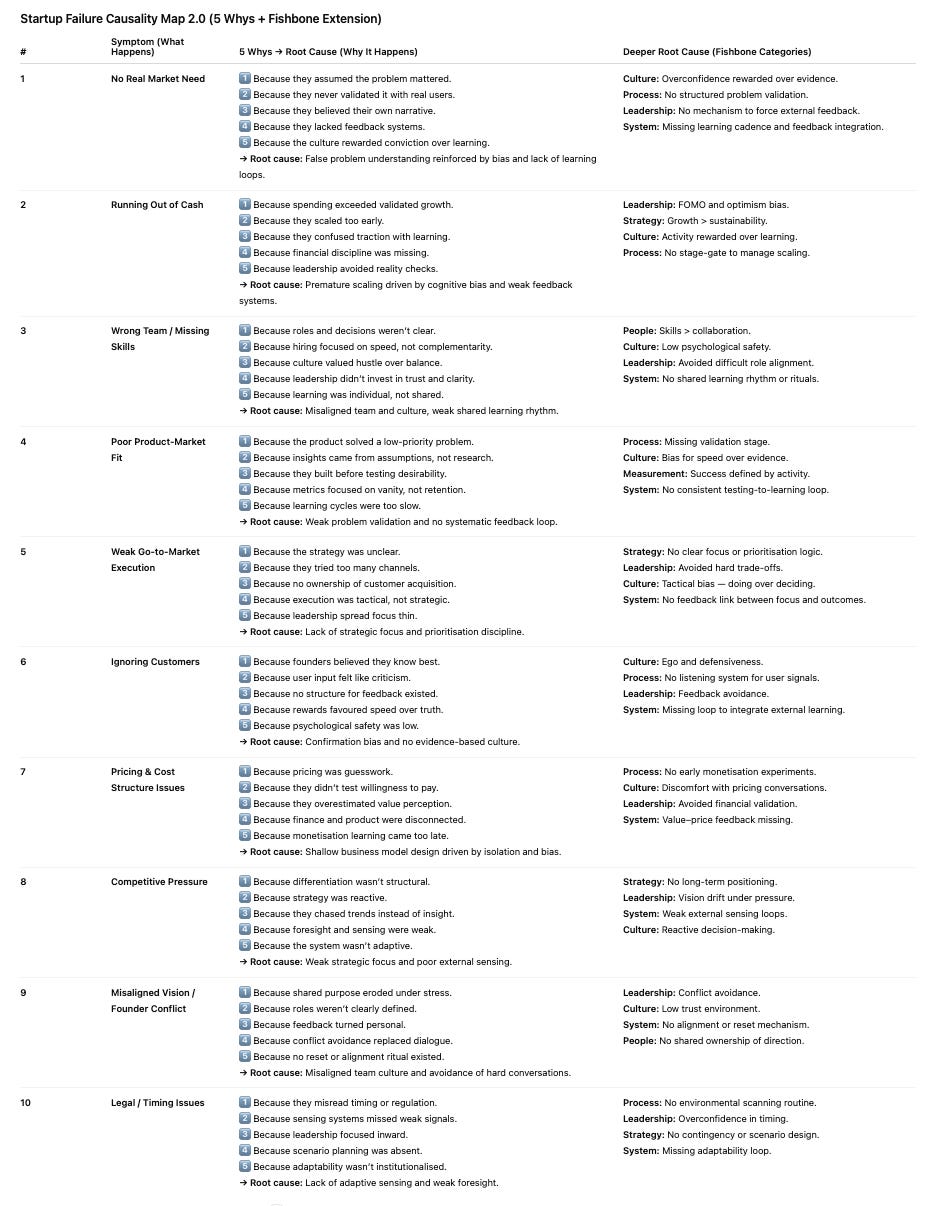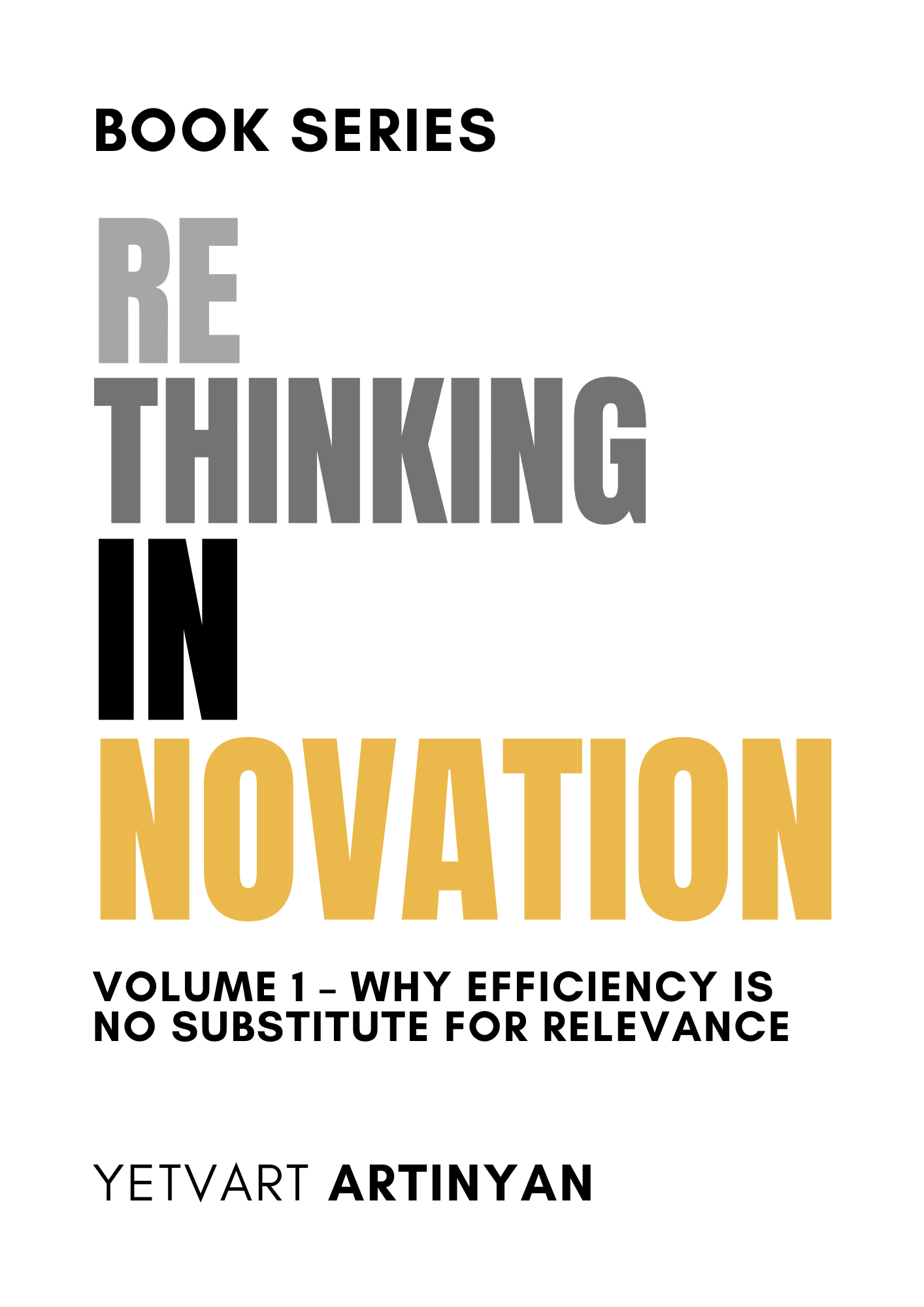Why Startups Really Fail: Looking Beyond the Symptoms

During my master’s thesis, I spent months researching why startups fail.
At first, it seemed like a solved question. There are endless lists online — and one, in particular, appears in almost every conversation about startup post-mortems: the CB Insights report on the top reasons startups fail.
You’ve probably seen it.
No market need.
Running out of cash.
The wrong team.
Poor product-market fit.
And so on.
It’s a useful list. But over time, I began to feel uneasy with it.
Not because the data was wrong — but because it was incomplete.
These reasons describe what happened when startups died. They don’t explain why it happened.
That’s when a simple idea hit me:
CB Insights described only the symptoms, what about the causing disease.
The Comfort of Symptoms
Symptoms are comforting because they’re visible. They let us believe failure can be avoided by checking off a list:
Find a market need.
Build a good team.
Manage your cash.
Execute well.
But when you look at hundreds of founder post-mortems, patterns start to blur.
One founder says they failed because there was no market need.
Another says because they ran out of cash.
Another because the team fell apart.
The truth is: these reasons overlap.
Running out of cash is a result of poor product-market fit.
Poor product-market fit is a result of solving the wrong problem.
Solving the wrong problem is a result of weak learning loops and unchecked assumptions.
It’s not ten separate reasons. It’s one system slowly breaking down.
From Post-Mortem Lists to Root-Cause Thinking
During my research, I borrowed a tool from operations and systems design: the 5 Whys method.
It’s a deceptively simple process — when something goes wrong, you ask “why?” five times until you reach the underlying cause.
I applied this to the ten most cited failure reasons from the CB Insights study.
The result was revealing.
When you keep asking “why?”, the conversation moves from facts to behaviour — from what happened to how people thought and decided.
Let’s walk through it.
What’s Seen vs. What’s Hidden
These are the ten failure symptoms everyone knows:
No real market need
Running out of cash
Wrong team or missing skills
Poor product-market fit
Weak go-to-market execution
Ignoring customers
Pricing and cost structure issues
Competitive pressure
Misaligned vision or founder conflict
Legal, regulatory, or timing issues
They’re all valid. But they live on the surface — the visible “what.”
To understand startup death, we have to descend to the “why.”
The Hidden Layer: Root Causes
When I ran each symptom through the 5 Whys and fishbone (Ishikawa), a deeper layer emerged.
Each reason connects back to patterns of behavior, bias, or system design.
Here’s what that looks like:
When I mapped these connections visually, a pattern appeared — a structure that revealed how each surface-level failure grows out of deeper system weaknesses.
Advertisment:
If you’re leading strategy or innovation, you probably feel this shift intuitively — but knowing where to act first is the hard part.
That’s why I built the Innovation Tool Framework, a structured system that helps teams map opportunities, validate assumptions, and prioritize real jobs to be done in the age of AI.
It’s built for leaders who want to move from hype to evidence — from ideas to systems that actually deliver value.
You can also explore my book series “Rethinking Innovation”. It’s not a get-rich project — just a way to share my thinking with anyone who wants to go deeper.
Volume 1 : – “Why Efficiency Is No Substitute for Relevance”, is free to download
Volume 2: - “The Twilight Zone – Where New Business Ideas Emerge”, download for only 1 Euro
Volume 3: “Problemize Zone – Understanding Job Performers and Their Jobs”, download for 1 Euro
Further Volumes are coming
What the Map Reveals
Look closely, and you’ll notice that every root cause eventually leads into one of three systemic failure modes.
These aren’t events. They’re behaviours — patterns that determine how a startup learns, focuses, and adapts.
1. Failure to Learn Fast Enough
Startups don’t die because they build the wrong thing.
They die because they don’t realize it early enough.
Most founders start with a hypothesis — a belief about what customers want. That’s natural.
But then they fall in love with their own idea and stop testing it.
The learning loop breaks.
They collect positive feedback, ignore contradictory signals, and keep building on top of unvalidated assumptions.
By the time the truth catches up, the runway is gone.
In this mode, failure isn’t sudden. It’s slow and quiet — a gradual disconnection from reality.
Antidote:
Build a culture of evidence.
Replace opinion with observation.
Measure learning speed, not just delivery speed.
The faster you learn, the longer you survive.
2. Failure to Focus Energy
The second pattern is about focus — or rather, the lack of it.
Many startups don’t burn out because of lack of opportunity, but because of too much opportunity.
When growth starts, founders feel pressure to scale, to expand, to “seize the moment.”
They hire too soon.
They launch new features too fast.
They chase multiple markets at once.
It looks productive — until the economics stop working.
Premature scaling is the most common hidden killer of startups.
It amplifies everything — including mistakes.
And underneath it lies a deeper issue: a lack of strategic discipline.
Saying yes to everything is just another way of saying no to focus.
Antidote:
Treat capital and attention as scarce resources.
Constrain growth until learning catches up.
Strategy isn’t about more — it’s about less, done deliberately.
3. Failure to Adapt as a System
The third pattern sits even deeper — it’s cultural, not tactical.
Startups are born in uncertainty. That means they must constantly adapt.
But many teams freeze.
As pressure builds, decision-making narrows.
Founders avoid conflict.
Teams stop sharing uncomfortable truths.
External sensing weakens — nobody’s watching what’s changing outside the building.
By the time the company realizes it’s misaligned, the market has already moved on.
Adaptation isn’t just reacting fast. It’s having systems that notice when you’re wrong — alignment rituals, transparent data, open conversations.
Antidote:
Build structures that make learning collective.
Create routines that surface tension early.
Adaptation isn’t a reaction — it’s a muscle.
From Linear Reasons to Systemic Understanding
When you combine these three systemic failures, the startup death spiral becomes clear:
You stop learning fast enough →
You spread your energy too thin →
You can’t adapt as a team or system →
You run out of cash, lose alignment, or miss the market window.
That’s the real story behind most post-mortems.
It’s not a single bad decision — it’s a series of small blind spots compounding quietly until there’s no turning back.
The Startup Failure Causality Map visualizes this process.
At the top, you see the surface reasons: cash, market, team, product.
Underneath, the behavioral roots: false assumptions, premature scaling, bias, misalignment.
At the base, the system failure: learning, focus, adaptation.
Three layers. One mechanism.
The Real Question for Founders
Instead of asking, “Why do startups fail?”, a better question is:
“How do startups stop learning?”
Because that’s when decay begins — when founders trade curiosity for certainty.
When “what we believe” becomes more important than “what we can prove.”
Running out of cash is just the moment the illusion ends.
How to Apply This
You can use this framework as a diagnostic tool.
Take any startup challenge — slow growth, team conflict, cash shortage — and trace it downwards.
Ask:
What’s the symptom?
What behavior drives it?
What belief or system allows that behaviour to persist?
For example:
Struggling with sales? Maybe not a marketing issue — maybe a false problem understanding.
Burning cash? Maybe not financial mismanagement — maybe premature scaling.
Losing talent? Maybe not culture fit — maybe misaligned learning loops.
Every symptom has a story.
The job is to keep asking “why” until the story changes from external to internal — from the world’s fault to your own structure’s design.
What This Means for Innovation Beyond Startups
These insights don’t just apply to startups.
Corporate innovation teams, accelerators, and venture studios fall into the same traps.
They build too fast, validate too late, and structure teams around delivery instead of discovery.
The same three systemic failures show up everywhere:
Learning speed replaced by project planning.
Focus replaced by activity.
Adaptation replaced by hierarchy.
Innovation dies the moment it becomes predictable.
A Personal Reflection
When I began this research years ago, I expected to find patterns in data and reports.
What I found instead were patterns in human behavior.
Every startup that failed had smart people, good ideas, and ambition.
What they lacked was a system to stay honest — to detect when their assumptions had expired.
In that sense, startups don’t fail because of bad luck or bad timing.
They fail because they stop listening — to their users, to their data, and to themselves.
The Takeaway
Startups rarely die of a single fatal mistake.
They die from a long series of near-misses they didn’t learn from.
The visible reasons — no market need, running out of cash — are just signals of deeper decay.
The real work of a founder isn’t to avoid failure. It’s to design a system that spots it early enough to learn from it.
The faster you learn, the longer you live.
The more you focus, the less you waste.
The better you adapt, the less you fear change.
Everything else — the lists, the metrics, the post-mortems — are just the symptoms.
Closing Thought
CB Insights gave us the vocabulary of failure.
Now it’s time to give it structure.
The next generation of founders shouldn’t just track what went wrong.
They should map why it went wrong — and design their systems to make that learning visible before it’s too late.
Failure, in the end, is not the opposite of success.
It’s the signal that something is waiting to be understood.
If you want to go deeper
Most startups don’t fail because the idea was wrong — they fail because they misunderstood why things stopped working.
I help founders, innovation teams, and corporates uncover these blind spots — using structured tools like the Innovation Flow, Go/No-Go Decision Canvas, and Customer Evidence Tracker to turn assumptions into real learning systems.
If you’re building something new and want to strengthen your innovation process from the inside out —
reach out at artinyan.com or connect with me on LinkedIn.
Because the best time to fix the root cause is before it becomes a symptom.






